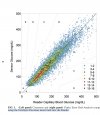Which is more stable in its instantaneous value?
Isn't CGM by far the more useful measurement?
Is there a good correlation between the two measurements?
How does the needle in the CGM sample the fluid? Does it not clog or get blocked with time?
Isn't CGM by far the more useful measurement?
Is there a good correlation between the two measurements?
How does the needle in the CGM sample the fluid? Does it not clog or get blocked with time?


